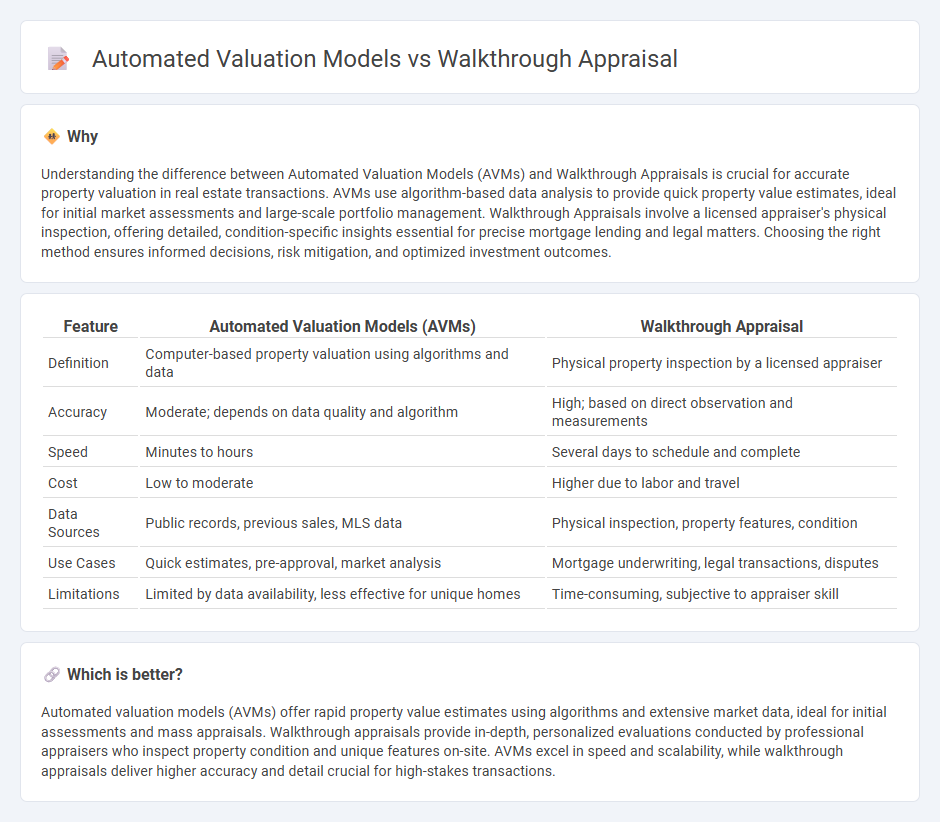
Automated valuation models (AVMs) use advanced algorithms and extensive property data to provide fast, data-driven home value estimates, enhancing efficiency in real estate transactions. Walkthrough appraisals involve a certified appraiser physically inspecting the property to assess condition, features, and unique attributes, resulting in a more precise and personalized valuation. Explore the differences between these methods and their impact on property assessment accuracy.
Why it is important
Understanding the difference between Automated Valuation Models (AVMs) and Walkthrough Appraisals is crucial for accurate property valuation in real estate transactions. AVMs use algorithm-based data analysis to provide quick property value estimates, ideal for initial market assessments and large-scale portfolio management. Walkthrough Appraisals involve a licensed appraiser's physical inspection, offering detailed, condition-specific insights essential for precise mortgage lending and legal matters. Choosing the right method ensures informed decisions, risk mitigation, and optimized investment outcomes.
Comparison Table
| Feature | Automated Valuation Models (AVMs) | Walkthrough Appraisal |
|---|---|---|
| Definition | Computer-based property valuation using algorithms and data | Physical property inspection by a licensed appraiser |
| Accuracy | Moderate; depends on data quality and algorithm | High; based on direct observation and measurements |
| Speed | Minutes to hours | Several days to schedule and complete |
| Cost | Low to moderate | Higher due to labor and travel |
| Data Sources | Public records, previous sales, MLS data | Physical inspection, property features, condition |
| Use Cases | Quick estimates, pre-approval, market analysis | Mortgage underwriting, legal transactions, disputes |
| Limitations | Limited by data availability, less effective for unique homes | Time-consuming, subjective to appraiser skill |
Which is better?
Automated valuation models (AVMs) offer rapid property value estimates using algorithms and extensive market data, ideal for initial assessments and mass appraisals. Walkthrough appraisals provide in-depth, personalized evaluations conducted by professional appraisers who inspect property condition and unique features on-site. AVMs excel in speed and scalability, while walkthrough appraisals deliver higher accuracy and detail crucial for high-stakes transactions.
Connection
Automated Valuation Models (AVMs) leverage algorithms and large datasets to provide quick, data-driven property value estimates, while Walkthrough Appraisals involve physical inspections by appraisers to assess property conditions and features. These two methods are interconnected as AVMs offer preliminary valuations that guide appraisers during walkthroughs, enhancing accuracy and efficiency in property assessments. Combining AVMs with walkthrough appraisals results in more reliable real estate appraisals by balancing quantitative data with qualitative insights.
Key Terms
Physical Inspection
Walkthrough appraisals involve a licensed appraiser conducting an on-site physical inspection to assess property condition, features, and unique characteristics, which enhances accuracy in valuation. Automated Valuation Models (AVMs) use algorithms and public data to estimate value but lack the nuanced insights from physical inspections, making them less precise for properties with unique or updated features. Explore detailed comparisons to understand which valuation method suits your property needs best.
Data Analytics
Walkthrough appraisals rely on expert evaluators conducting physical property inspections, integrating qualitative data and on-site observations with market trends and historical data to produce accurate valuations. Automated Valuation Models (AVMs) utilize advanced algorithms and machine learning techniques to analyze large datasets including comparable sales, property characteristics, and market conditions, providing rapid, scalable estimates with high consistency. Explore in-depth data analytics methodologies underpinning both approaches to enhance real estate valuation accuracy and efficiency.
Valuation Accuracy
Walkthrough appraisal offers higher valuation accuracy by incorporating a licensed appraiser's detailed inspection of property conditions and neighborhood factors, capturing nuances often missed by Automated Valuation Models (AVMs). AVMs leverage algorithms and large datasets to provide quick, cost-effective estimates but may lack precision in unique or rapidly changing markets. Explore the differences in valuation approaches and their impact on property assessments to make informed decisions.
Source and External Links
What to Expect During an Appraisal Inspection - This walkthrough appraisal guide explains the steps involved in the appraisal process, including expectations during the on-site visit and how to prepare for it.
Conducting an Observation or Walkthrough Appraisal - This resource provides a step-by-step guide on conducting walkthrough appraisals in educational settings, focusing on digital tools for observations.
A Guide to Understanding Residential Appraisal - This comprehensive guide covers various aspects of residential appraisals, including the walkthrough process for evaluating properties.
 dowidth.com
dowidth.com